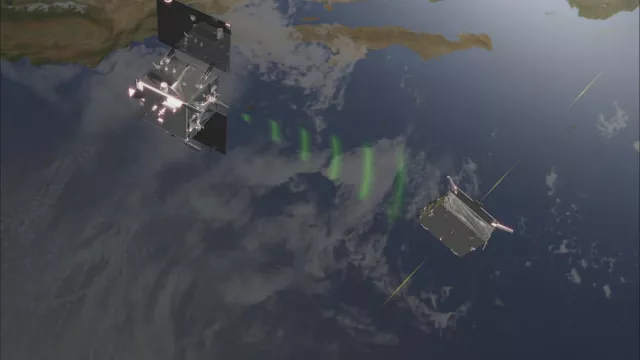From 2010 to 2012, the two satellites on the Prisma orbital technology demonstrator mission tested a range of autonomous formation-flying technologies and validated rendezvous algorithms.
FFIORD (Formation Flying In Orbit Ranging Demonstration) was a CNES experiment dedicated to the rendezvous component of this mission.
Key information
| Mission | In-orbit validation of rendezvous and formation-flying technologies |
|---|---|
| Domain | Cross-cutting |
| Launch date | 15 June 2010 |
| Partners | SNSB (Sweden), DLR (Germany), DTU (Denmark), SSC (Sweden), CDTI (Spain), Thales Alenia Space |
| Where | 710-km Sun-synchronous orbit |
| Lifetime | Initially planned for 10 months, extended to end 2014 |
| Status | Completed |
Key figures
Prisma
- 2 satellites flying in close formation
- 145 kg: mass of primary Mango satellite
- 40 kg: mass of target Tango satellite
- 4 relative-positioning instruments
FFIORD experiment
- 1 RF relative-positioning instrument + guidance, navigation & control (GNC) software
- 83 days of experimentation
- 400+ manoeuvres
- 3 vision-based rendezvous demonstrations
Key milestones
- July 2014: RV with Picard scrubbed due to depletion of fuel, end of mission
- March 2013: De-activation of Tango and transfer to rendezvous with Picard
- Mid-2011: Start of extended mission
- 15 June 2010: 2 satellites launched by Dnepr
- June 2006: Prisma-FFIORD project kicks off
Project in brief
Funded by the Swedish National Space Board (SNSB), the Prisma mission was conducted in partnership with Denmark, France and Germany. Its two satellites, named Mango and Tango, were launched on 15 June 2010 by a Dnepr vehicle from the Yasny launch base in Russia. For 2½ years, the 140-kilogram Mango primary satellite repeatedly approached and receded from the 40-kilogram Tango target satellite.
From 28 October 2010, CNES took control of Mango for a total of 30 days to perform the FFIORD experiment (Formation Flying In Orbit Ranging Demonstration), designed to validate manoeuvres for satellite separation distances from 10 kilometres down to 50 metres. The relative position of the two satellites was measured by radiofrequency sensors developed by Thales Alenia Space and GMV with funding from CNES and Spain. Mango’s autonomous movements were controlled by navigation and guidance algorithms developed by CNES. Operations were also planned and monitored using a Flight Dynamics System (FDS) developed by CNES.
From November 2011 to September 2012, CNES performed a series of additional experiments, including vision-based rendezvous, short-distance transitioning from radiofrequency control to close optical control, and reconfiguration and formation-maintaining manoeuvres representative of a universe science mission. The last experiment in 2014—to rendezvous with a non-cooperative target, the Picard satellite—unfortunately had to be scrubbed before final approach when fuel ran out.
The diverse range of operations performed by Prisma and the FFIORD experiment has significantly advanced in-orbit validation of close formation flying and orbital rendezvous techniques, working within very tight schedule and cost constraints
CNES’s role
CNES contributed to the Prisma mission through the FFIORD experiment devoted to demonstrating rendezvous and formation-flying operations using a new generation of sensors.
The nominal mission, from August 2010 to March 2011, used the FFRF radiofrequency sensor developed by Thales Alenia Space and co-funded by CNES and CDTI. Additional activities were pursued in October-November 2011 and then in September 2012 as part of the extended mission. The overall mission was a success, providing CNES and its partners significant experience with this new technology. It was funded by the Swedish National Space Board (SNSB) in partnership with CNES, the German space agency DLR and the Technical University of Denmark (DTU).
CNES subsequently formed a specific partnership with OHB-Sweden to perform a non-cooperative rendezvous with the Picard satellite. The agency contributed to mission analysis and was in charge of computing transfer and final approach manoeuvres.
For any questions, please use the contact form.


